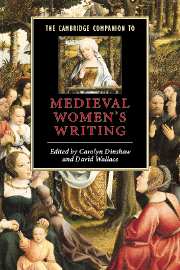7 - Enclosure
from Part II - Texts and other spaces
Published online by Cambridge University Press: 28 May 2006
Summary
Where the view is held that a body contains something - as it is now and was in the Middle Ages - every person lives in an enclosure. But a particular form of medieval devotion also elaborated this structural metaphor as an entire way of life, arranging a person's every daily thought and activity so as to limit even the body's contact with the world, enclosing that person permanently within the protections of a dwelling. Because the defining gesture of such devotion was complete withdrawal from social encounters, enclosed men and women were called 'anchorites' after the Greek anachorein, meaning 'to retire, retreat'. Since such isolation was, by its nature, a piety of strict discipline, an anchorite also tried to leave behind all physical comfort, and the anchoritic dwelling was itself often painfully small, sometimes no more than eight feet (2.4 m) square. It was commonly attached to the north side of a church so that the anchorite’s main outward view would be through a window which faced the altar (but even this opening was sometimes no more than twenty-one inches (53 cm) square). The dwelling could also have two other windows, one for obtaining food and other necessities, the other for communicating with priests or visitors, but, even here, communication was limited; these windows were mostly kept closed, and when opened were still to be covered with a curtain. Although the dwelling had to have a door for the anchorite to enter in the first place, it was blocked up as part of the ceremony of enclosure, at which point the Office for the Dead and prayers for the dying were said. Once enclosed, in other words, the anchorite was only meant to leave his or her dwelling in death, and its narrow confine was therefore, in principle as well as practice, not so much a house as a tomb.
- Type
- Chapter
- Information
- The Cambridge Companion to Medieval Women's Writing , pp. 109 - 123Publisher: Cambridge University PressPrint publication year: 2003
- 3
- Cited by



